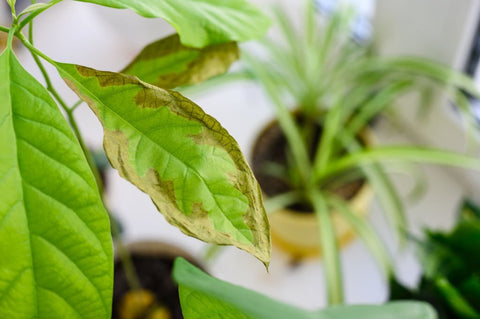
Humidity is such a common everyday term that you probably don’t think much about it when you hear the weather report. But what is it exactly, and how can humidity affect your plants?
Usually, houseplants come with care instructions that explain the optimal temperature and humidity levels for the plant itself. Humidity plays a big role in how your houseplants grow and develop, and it’s important to watch your household’s humidity levels to ensure your plant is in the right environment.
What is Humidity?
Before getting into how you can control the humidity around your houseplants, let’s go over what humidity is. In short, humidity is the amount of water vapor present in the air. Depending on the temperature of the air, this water vapor may also condense. The temperature value at which water condenses is called the dew point.
Determining Humidity Levels
Humidity is directly tied to the percentage of water particles in the air. The higher the humidity, the wetter it feels outside. When humidity levels reach 100%, there is so much moisture in the air that it condenses and rains.

Photo by Anastasia Gubinskaya
Typically, your humidity level will scale with temperatures; the warmer the weather, the higher the humidity. However, some climates, like deserts, have little moisture in the air despite their heat. In these climates, plants don’t really need to take in water through their leaves, as jungle plants do.
[Humidity Levels]How to Find Your Humidity Levels at Home
Everyone’s house has different humidity levels, depending on the environment’s average temperature, location, and airflow. Generally speaking, 40% humidity is considered the average “low” value, while 50-60% is considered a bit on the higher end. Regardless of where you live, your humidity levels will never reach zero.
To measure humidity in your home, you can either purchase a hygrometer or a humidity thermometer from a store or use household methods. Scientific tools like the temperature/humidity thermometer will provide more accurate readings, but they can be expensive. If you’re planning to do a general check, pour yourself a glass of water, and place three to five ice cubes in it. Then, place the glass somewhere so it won’t get bombarded with warm or cold drafts. Wait five minutes, and then check to see how condensation forms on the side of your glass. If there are large condensation droplets that slide down the side of your glass, your humidity levels are a bit high.

Using humidity thermometer to measure humidity in your home.
Photo by Daria Sakharova
[Humidity Signals]Signs Your Houseplants Need Higher Humidity
Houseplants that drink through their leaves are more likely to prefer higher humidity levels over lower ones. Here are the most common signs your houseplant is struggling with low humidity:
Drooping Leaves
If your plant’s leaves are drooping like it needs a drink, it probably does– humidity can affect how quickly your plant absorbs water from the soil. Lower humidity levels usually cause plants to drink faster, while higher humidity levels slow down absorption.
Leaves Turning Brown or Yellow
Browning and yellowing leaves can mean a lot of things, but if the leaves start changing color at the tips and around the edges, low humidity is a likely candidate for the cause.

Browning and yellowing leaves is the signal of low humidity.
Photo by Nikita Burdenkov
Crispy Leaves
Crisp, dried-out leaves are another sign that your plant may need a drink or some wetter air. Watch for brittle leaves on all of your plants to ensure they stay adequately hydrated.
[Increase and Control Humidity]How to Increase and Control Humidity Around Your Houseplants
So, how do we help plants that need higher humidity levels? There are several things you can do to both increase humidity and control humidity levels in your home:
Get a Humidifier/Dehumidifier
A humidifier and/or dehumidifier are great tools for adding and removing moisture from the air. Simply fill your humidifier with water and turn it on near your plants to boost humidity. If your houseplants need lower humidity levels, use a dehumidifier to collect extra moisture from the air.

A humidifier and/or dehumidifier are great tools for adding and removing moisture from the air.
Photo by aapsky
Mist Your Houseplants Regularly
Misting is another popular way to control the humidity around your houseplants, and this method works best with plants that don’t require extremely high humidity levels to thrive. Misting is only temporary, so you’ll have to do it regularly to ensure your plant gets enough moisture.
Some plants, however, should never get a good misting. Houseplants with “hairy” leaves like the Purple Heart and succulents like Echeverias will not absorb water through their leaves. Instead, the water droplets will sit and potentially cause infection in the plant.
Keep Plants in a Terrarium
If you’ve ever worked with a greenhouse, then you know that enclosed spaces with plenty of light are great for retaining high humidity levels. Terrariums work the same way– you’ll just need to stick with smaller plants.
The Pebble Trick
Another popular favorite, the “pebble trick,” involves placing your plant over a tray of water with pebbles underneath. As long as you fill the tray about halfway with water and avoid letting your pot sit in the water, this method works well for slowly raising humidity throughout the day.

Using "pebble trick" is one way to control humidity.
Photo by Dorling Kindersley - Rob Streeter

 Calathea
Calathea Philodendron
Philodendron Air-Purifying Houseplants
Air-Purifying Houseplants Best Houseplants For Beginners
Best Houseplants For Beginners

